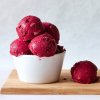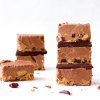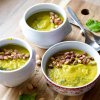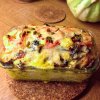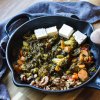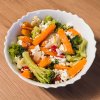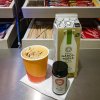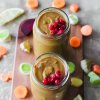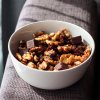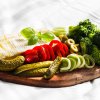JUMP TO
Learn how to put together a healthy school lunch for your kids and why it’s mandatory that kids eat plenty of whole foods. These solutions really work!
When it comes to children and the food they eat, we all have a big problem. Our children are getting more and more unhealthy and, a big part of this obesity epidemic, it’s due to what we call food.
Let’s focus on solutions! My motivation for this article is to show you what makes these foods unhealthy and what are the healthy alternatives. Our children deserve better healthier food and I will do my best to show you my solutions for a healthy school lunch.
The link between children’s health and genetics
In recent years we have come to understand that it’s not the genes that dictate our health, but it’s the way our genes are expressed. The truth is that we all have the same genes so, what really separates us in terms of development in life, is the way we express our genes.
According to Dr Bruce Lipton, a leading expert in the field of Epigenetics, “We are not a victim of our genes because we control our genes”.
What does this really mean exactly? It turns out that disease develops as a direct consequence of the way we express our genes. Not because some of us have “good” genes or “bad” genes. Not because of chance and certainly not because it’s our faith to be healthy or to get sick.
Dr Bruce Lipton talks about how the environment that we live in influences our genes. Simply put, we get sick due to the way we perceive and understand the environment we live in. The choices we make, how we look at life, what we eat and how we think, all of these are factors that influence our gene expression (the way we express our genes).
Food plays a big role on this epigenetics puzzle because food influences how our physical body functions. Without proper food we can’t function correctly, regardless of how much stress we have in our life.
Food is huge when it comes to the way our body works, repairs and regenerates itself over time. The food that we eat dictates the state of our immune system and how we develop in life. That’s why it’s mandatory to give children the food that will nourish their bodies every single day.
The problem with kids school lunches
We have to ask ourselves what are our kids really eating? What exactly goes into their school menu or into the food that they are eating daily?
Everyone’s busy, I get that. But what if I told you that, with a little bit of initial effort, you could have your children eating only health-promoting foods? What would be like to know that your children are protected for all kinds of diseases because their immune system is strong?
Let’s look at some of the unhealthy ingredients that go into school lunches these days:
Sugar, Sweets, Candy
If we agree on a food that is totally bad, that’s sugar and products that contain sugar. Sugar is bad for everyone and it’s not ok even in small quantities. Unfortunately, these days we add refined sugar to almost all the conventional foods, and we end-up eating way too much of it on a daily basis.
Sugar is bad for the immune system because it curbs immune system cells that attack bacteria. This effect lasts for at least a few hours after consuming sugar.
But that’s not all, sugar impacts virtually the entire function of the body, from digestion to brain. We need to understand that “sweet” is in fact a perception of our brain. The same perception of “sweet” is not equal for everyone and it can also be adjusted if we make a conscious effort to do so.
Breakfast Cereals
Breakfast cereals are made from processed grains, often mixed together with refined sugars, refined carbs and other unhealthy ingredients. They are so low in beneficial nutrients that, in order to pass any kind of nutritional inspection, the breakfast cereals need to be fortified with vitamins and minerals.
They are often marketed as “low-fat” and “whole-grains” to increase sales, while in fact they are foods devoured of any kind of beneficial nutrients. They are bad for digestion and loaded with sugar, yet these products are marketed as “rich in fiber”.
Last, but not least, cereals come with anti-nutrients like phytic acid and gluten, which will simply contribute to all sorts of mineral deficiencies (phytic acid), digestion and allergies issues (gluten).
Bread and Toast
We all have “enjoyed” a warm slice of toast and jam in the morning, before going to school. But you know what? Our kids deserve better!
Toast is simply bread that is heated up to the point that it becomes toxic. Toast is loaded with free-radicals while having the same high glycemic index that “regular” bread has. In the body this leads to oxidation and high insulin production, which in turn lowers the function of the immune system.
If you need to consume toast, at least make sure that it doesn’t end-up being brown or black, because that’s where even more of the toxic substances will develop.
Pastries, Cakes, Donuts
The pastries that we find everywhere these days don’t have anything in common with grandma’s pastries. These products are loaded with the 3 most toxic ingredients you can find: refined sugar, refined seed oils and white flours.
That’s not to mention trans-fats, low-quality jams or cheeses, additives and the toxic effects these “extras” add to the whole package. Oxidation, bad digestion, constipation, lowered immune system, rashes, irritability, anxiety, all of these are side effects of the pastries and cakes that we are bombarded with everywhere.
Milk
Unless the milk comes from healthy animals that spend lots of time in the sun, eating fresh green grass, you need to think again about the benefits of milk.
Most of the milk that we find on the shelf today is pasteurized, homogenized and aseptic processed (UHT). This simply means that this so-called “milk” it’s very low in micronutrients like enzymes, beneficial bacteria, vitamins or minerals.
If you look closely at the label you’ll see that, instead of retaining its own vitamins, they often add in synthetic vitamins to compensate for what is lost in the “processing” phase. This so-called milk doesn’t have anything in common with the fresh raw milk that kids should consume.
Consuming supermarket-milk leads to bloating, food allergies, obesity, cardiovascular problems, digestion problems and other associated issues. Milk is often consumed with other unhealthy foods like breakfast cereals, bread or pastries, which come with their own negative consequences for one’s health.
Processed Meat
One of the most popular food items found in school lunches is processed meat. This can be anything like burgers, sausages, pastrami, salami, chicken breast, schnitzel, etc.
What all these products have in common is the simple fact that they’re processed in a factory. In terms of ingredients this translates to using additives, preservatives and fillers, on top of refined seed oils, often white flours, soy, and others. Not to mention the fact that meat is only a small part of the end products, and that’s especially the case with sausages.
But that’s not all! Most of us tend to eat too much meat anyway because we’re taught so from an early age. This in turn means that we are not getting all the vegetables that we really need in order to thrive.
Processed meats are often eaten with lots of white bread, which can only contribute to a low-nutrient meal. That’s one of the paths that can lead to long-term nutrient depletion and disease.
Pizza
One of the most popular items that we often see kids eating is pizza. It may be easy to buy a pizza slice, it may seem tasty, but how healthy is pizza?
Simply put, pizza incorporates all of the unhealthy ingredients that we’ve discussed so far. From sugar, to refined flours, processed meats and low-quality cheese, pizza is one of my top 5 toxic foods that you can eat daily.
And to put more gas on fire, ready-made pizza (frozen pizza) is even worse. Frozen pizza is loaded with preservatives and additives, which contribute to sabotaging one’s gut health and the immune system.
Fruits
Fruits are full of vitamins and kids love them but, like anything else in life, too much fruit (especially sugary fruits) can be unhealthy. Most of the fruits are loaded with sugar (fructose = sugar in fruits) and we need to make sure that kids don’t consume these fruits in excess.
Another problem with fruits is the way they ripen. If they are in season where you live, well … that’s great and your kids should enjoy them! Personally I don’t like the idea of consuming fruits that are ripened in storage, and I don’t approve of consuming too many fruits that aren’t in season.
Naturally ripened fruits that are in season where you live are the ones that you should aim for. These come with more nutrients per serving, especially if they are organically grown. If the fruits aren’t organically grown, make sure to wash them properly before consuming them, to remove any kind of pesticide residues.
Restaurant Menus
This special category of foods are actually marketed as healthy, kids being the main target of these marketing campaigns. Think about McDonalds, KFC, Burger King, or other popular fast food chains. We can even find unhealthy foods like these in almost all restaurants, no matter how expensive the menu is.
These menus have a simple template that usually consist of some form of sandwich or burger, soda and fries. These so-called “foods” are loaded with refined sugars, refined seed oils, white flour, additives, preservatives, fillers.
The cumulative effects of giving your child something like this for lunch are the obesity epidemic that we see today in our children’s generation. But that’s not even close to the true image of this food-induced mass-disease experiment.
In order to understand the whole picture, we should also look at the increasing depression rates in children, attention deficiencies, lower immunity, anxiety, low energy, and a whole list of other toxicity induced diseases. Burgers, soda, fries, etc are not healthy and should be avoided completely, especially for children.
What to eat instead and why
Instead of the above-mentioned foods, there are plenty of healthier food options to choose from. Start by reading the ingredients lists at the grocery store or at the restaurant, and look for ingredients whose names you understand. It’s important to do your research and understand what these products contain.
Here are a few tips of help you understand and avoid some of the unhealthy products or ingredients out there:
- Always aim for whole foods, unprocessed or processed as little as possible.
- Choose products that were grown in a responsible way – eg: organic, pasture raised, free range, chemical free, fair trade, etc
- Avoid products with ingredients whose names you can’t pronounce or don’t know what they are.
- Avoid all hydrogenated or partially hydrogenated oils in the ingredients lists.
- Check the nutrition label for things without trans-fats.
- Avoid all ingredients that start with E (these are usually man-made factory processed substitutes).
- Avoid all additives and preservatives in any kind of food.
- Avoid pasteurized products because they lack even the basic micronutrients (specially naturally occurring enzymes, healthy probiotics, or vitamins).
- Know that, if ingredients like sugar, wheat, oils are present at the top of the ingredients list, this means they are a big part of the entire product.
- Products with added vitamins and minerals are products that were heavily processed to the point that all their micronutrients are destroyed.
- While fermented vegetables are super healthy, pasteurization kills all the beneficial bacteria. If you buy fermented vegetables, they should have live bacteria – the easiest way to verify this is to buy them from a refrigerator shelf (cold temperature slows down the multiplication of those bacteria populations, that is why they are kept on a refrigerator shelf).
- Avoid soy and products that contain soy, unless the soy use was fermented as in the traditional Japanese cuisine, Soy is a legume that comes with many anti-nutrients (lectins, phytic acid), but also phytoestrogens (which interfere with your hormones) and enzyme inhibitors (which interfere with protein digestion).
- One rule that I like to use is: “If man made it, you can’t eat it” (by Dr. John Bergman)
Read more: A Simple Guide to Healthy Food Choices
This is what a healthy school lunch should contain
- Lots of Vegetables – In my opinion, a healthy food plate should always start with plenty of colorful home cooked vegetables. You can use fresh or frozen vegetables here, but they must be home cooked without trans-fats or refined seed oils. The vegetables should be a big part of each portion and you should make an effort to choose locally grown vegetables that are in season where you live. If you can buy organic that is always a plus. Another trick is to avoid overcooking the vegetables to the point where all the micronutrients are destroyed.
- Legumes – Legumes are the seed of the plant and they are part of the Vegetables family. With this being said, legumes (except for soy) can prove to be very healthy if they are prepared correctly (soaking prior to cooking). Same as with vegetables, legumes are relatively easy to cook and super tasty. Legumes can be easily combined with vegetables or with the other categories of foods that I’ve listed below.
- Healthy Fiber – Cooked vegetables and legumes come with a type of fiber called resistant starch, which is beneficial food for the gut flora. Knowing that 70% of the immune system is in the gut, nurturing those gut bacteria is like working to improve the immune system with every meal. Every time your child eats this type of fiber, you’re making an investment in their health.
- Meat, Fish, Fowl – These foods should definitely not be the only thing on the plate. You can easily pair them with lots of vegetables and some correctly prepared legumes. Make sure to cook without using refined seed oils or trans-fats, which are unhealthy due to their quick oxidation (when exposed to heat, light, and oxygen). You can safely use these fats for all your cooking: butter, extra virgin olive oil, extra virgin coconut oil or avocado oil.
- Eggs – Eggs are a great source of protein but also healthy fats, plus vitamins and minerals. You can cook eggs in many different ways, from boiled to scrambled, to a frittata in the oven and anything in-between. You can combine eggs with vegetables or serve the vegetables as a side. The trick to cooking perfect eggs is to use the best eggs possible (free range from healthy chickens) but also to use butter instead of oil.
- Fruits – Fruits should always be eaten in moderation and my advice is to aim for locally grown fruits. They work great as a treat between meals or as a quick recovery snack. Fruits are great on their own but they can also be combined as part of a meal. For instance, I like to combine apples with my favorite French Brie or Camembert, and I like to cook using oranges or limes. Grapes work great with a mature cheese like Brie, Camembert, Cheddar, or Comté cheese.
- Healthy Cheeses – Cheese is a great source of protein, healthy fats, vitamins, minerals and enzymes, but only if the milk was obtained from healthy animals and the cheese was processed as little as possible. One way to identify a healthy nourishing cheese is to buy it from local farmers that have generations of experience. Living in Europe, I either buy from local farmers myself or I buy traditional cheeses made by farmers from countries like France, Switzerland, Italy, Austria, UK, Netherlands or Romania. I always shoot for raw milk or lightly pasteurized milk, trying to vary the cheeses as much as possible (I like almost everything from brie to Camembert to Comté, Cheddar or Schweitzer).
- Homemade Dessert – I have written extensively on the benefits of homemade desserts and you can find plenty of healthy desserts on this website. My advice is to ALWAYS make your own desserts instead of buying from the store. This way you’ll be sure that you’ll be using only the best ingredients, plus this can be a fun family activity. Shoot for low-carb desserts, with plenty of natural healthy fats and quality proteins. In the last few years I have come to realize that a healthy tasty dessert is actually easier to make at home than one of those high sugar cakes.
- Nuts, Seeds, Nut Butters – These are great as extras to any meal or served on their own. The trick is to avoid anything with added ingredients like sugar, sirups or added oils. Roasting is also a thing that should be avoided or at least kept at the minimum, since heat destroys the fat profiles in nuts and seeds. Nut butters are also very popular and they are a great inexpensive treat on their own. Nuts should be prepared correctly by first soaking them in warm water with a salty solution to activate their enzymes. The soaking process makes nuts easier to digest, but it also inhibits some of their anti-nutrients (namely phytic acid).
- Dried Fruits – These are a great addition to any kind of dessert to treat, as long as they are naturally dried without sugar. Medjool dates, prunes, raisins, dried figs are all great examples but they must be free of sugar and preservatives. Read the labels, making sure to avoid any kind of hidden ingredients (hint: the label shouldn’t contain extra ingredients!).
Conclusions
We need to make healthy food and healthy eating a priority for our children. We need to take responsibility for the food that we give to our children. I don’t care if this means taking time off social media, or if it means reading 10 books on top of your job.
Taking control of the food that your child is eating is the first step towards giving your child a healthy immune system, that will be with him/her the entire life. It may be hard to change everything at once and I get that. But with a consistent effort and an open heart, YOU WILL BE ABLE to make positive changes that will benefit your child his entire life.
Read more on how to change your habits, one step at a time.
Think about it! What better gift to give to your child than to give them the gift of health? And it all starts in their gut. It all starts with that healthy family breakfast or with a healthy school lunch.
Further reading:
- 10 Tips for Making Healthier And Conscious Food Choices
- Vegetarian and Vegan Healthy Foods For Your Pantry
- 18 Low-Carb Desserts That Inspired My Health Journey
How do you handle school lunch for your children and what kind of foods they enjoy? Share your amazing tips in the comments!








